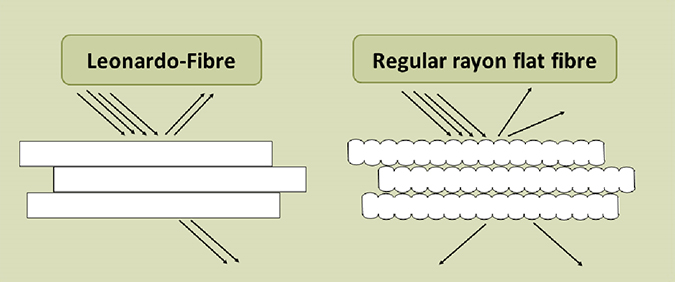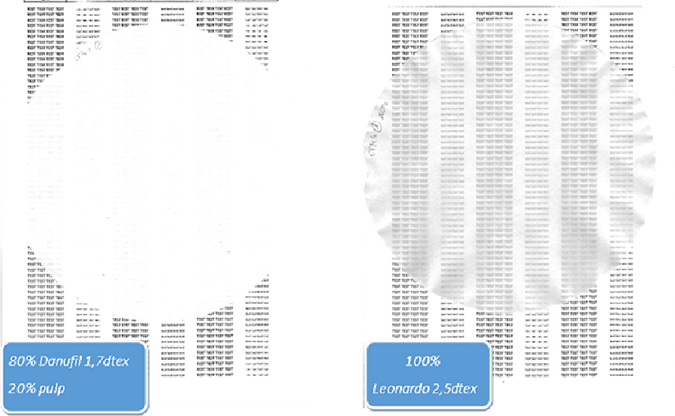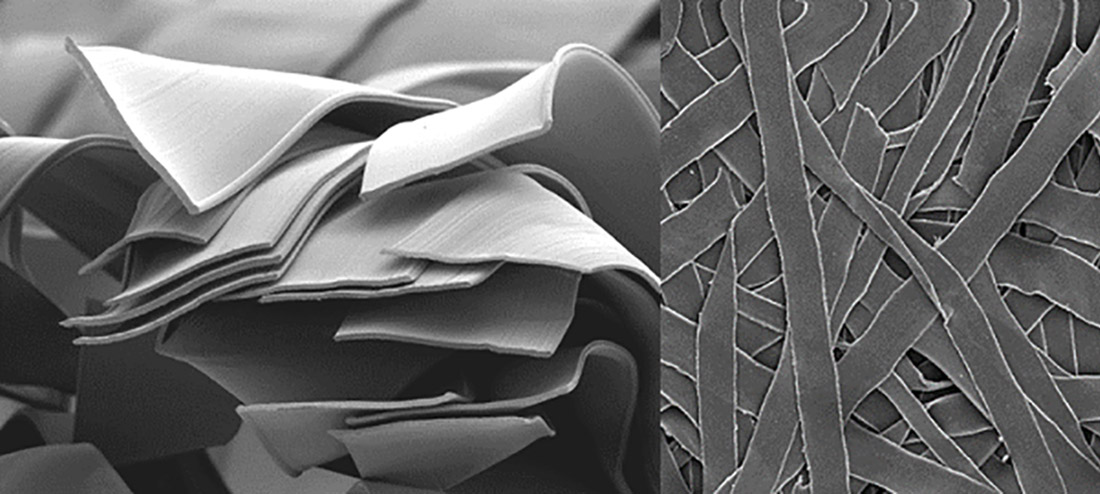Viscose fibers are manmade fibers produced from 100% cellulose pulp. Although the viscose process was introduced more than 100 years ago, development of new viscose fiber types is still ongoing, driven by a trend to highly functionalized products and lately by an increasing demand for biodegradable fibers based on renewable resources.
Due to its high versatility, the viscose process is suited to produce modified fibers with specific properties. These fibers can be used to introduce functionalities into a diversity of finished products, ranging from paper and nonwovens to textile end-uses in such fields as filtration, personal hygiene or fashion apparel.
As a leading producer of viscose specialties, in recent years Kelheim Fibres has developed various specialty fibers used to enhance specific features in these products. Functionalized fibers can be manufactured by different routes, such as the incorporation of functional particles and polymers or by applying special-purpose aftertreatments.
But modification of the cross-section of viscose fibers can also be used as a tool to provide unique properties to the fiber and the products made from them, as is the case with Leonardo fiber.
Leonardo fiber
Leonardo fiber is a viscose fiber with a highly modified cross-section. The fiber is extraordinarily thin and flat, with a width to thickness ratio from 1:20 to 1:40, depending on the specification.
An example of this high aspect ratio for a fiber of 2.5 dtex results in a fiber width of approximately 65 µm and a thickness of only 2-3 µm.
Compared with regular “round” shaped viscose fibers, this thickness corresponds to the cross-section diameter of a 0.1 dtex fiber, a fineness so far not commercially available for viscose fibers.
Additionally, the Leonardo fiber surface is completely flat and smooth, while the surface of regular viscose fibers is crenelated and irregularly shaped.
And while regular viscose fibers always show some variability in the cross-section, the Leonardo fiber cross-sections are very homogenous with completely parallel fiber surfaces.
This special shape is useful to introduce specific properties into a range of applications. Therefore, the Leonardo fiber is commercially available in 2.5 dtex and 9.0 dtex to suit the different target product categories and is produced as a staple fiber in 32 mm and 40 mm for nonwoven and textile applications, as well as wet short-cut in 3-12 mm for wetlaid and paper products.
Wetlaid and paper applications
Perhaps the most straightforward use of the fiber is in wetlaid and paper applications. Owing to the very flat and smooth surface, the fibers are predominately orientated co-planar to the paper or nonwoven plane when applied in wetlaid processes (Figure 1).
This results in a high fiber-to-fiber contact area and thereby a high degree of bonding, density and tensile strength compared with sheets made from regular regenerated cellulosic fibers.
An important feature of these sheets is their high transparency. While the cellulose polymer is transparent in nature, usually a high degree of light scattering on the fiber surface minimizes transparency.
The increased area of fiber contact, the parallel orientation of the fibers, as well as the flat fiber surface, reduces the light scattering in wetlaid or paper products made with Leonardo fibers, rendering them transparent (Figure 2).

While in most paper applications a rather high opacity is targeted, there are also a series of specialty products, for example in the food filtration segment, where a high opacity is desired, which is difficult to achieve by means other than by a mere reduction of the basis weight (Figure 3).

Nonwoven applications
A prominent application in the nonwoven area where a high transparency is desirable is the product class of cosmetic facial masks. These facemasks are often worn in public, so a maximum of transparency offers the highest discretion in use.
Thin hydroentangled fabrics with a low basis weight of 30-45 g/m² are commonly used in this application to provide good transparencies.
When including Leonardo fiber in the fiber blend for these nonwovens, the fibers are also predominantly orientated with the fiber plane in parallel to the nonwoven plane, thus providing improved transparency.
In general, the wet opacity of nonwovens from cellulosic fibers correlates with the dry opacity, but is much lower. Wet nonwovens including Leonardo fibers can therefore appear almost completely transparent when in contact with the skin.
The masks are applied to the face together with a lotion, so a high lotion pick-up and a good skin-fit are also important features of a nonwoven facemask besides wet transparency.
Nonwovens made with Leonardo fibers do not show particularly high absorption under increased pressure, but under the in-use condition of no applied pressure, the flat fiber shape holds the liquid within the nonwoven structure.
This results in a higher lotion-holding capacity than can be achieved with comparable nonwovens using round or irregularly shaped fibers. Further, the high flexibility of the fiber in plane with the nonwoven provides a high level of skin fit in the wet condition.
Blends including 30-70% of Leonardo fiber are recommended to achieve the best overall performance in terms of transparency, lotion-holding capacity, skin fit and wet tenacity.
Textile applications
Although it might be an interesting feature, Leonardo cannot induce transparency into textile yarns, since the fiber axes do not lie in the same plane.
Of course, a single fiber is still highly transparent when undyed. But, as also shown in Figure 2, owing to its broad and planar surface area, the fiber also has a high capacity to reflect light without diffusion, when illuminated by direct light, similar to a small mirror.
Taking advantage of this effect, by blending Leonardo with other fibers in yarns, fashionable effects can be achieved in textiles, ranging from single sparkles when using 5-10% of Leonardo, up to an overall shiny appearance of the textile when adding 30-50% of Leonardo (Figure 4).

The visible effect is best achieved when the textile is dyed at deep shades or by blending Leonardo with spun-dyed fibers.
In ring-spinning, Leonardo blends can be converted to yarns with regular settings as used for viscose fibers of the same decitex, achieving good yarn properties.


